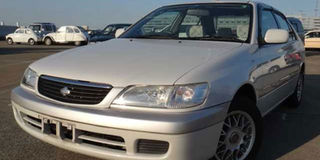Ask the mechanic >What is the consumption of a Premio?

The fuel consumption of any car is determined by its engine size and whether it is being driven on a highway or in urban traffic. FILE PHOTO
Dear Paul,
Thank you for the good work. I have a Toyota Corolla AE100 (Kikumi) but would like to replace it with a Toyota Corona ST190 (Kibina) very soon.
Kindly advise me on the pros and cons of the Corona ST190 and the year of manufacture I should look for in comparison with the Toyota Corolla 1993 model. Thank you
Stelsonic.
Hello Stelsonic, comparing the Toyota Corona ST190 and the Toyota Corolla AE110 is not exactly comparing apples for apples. Toyota designed and built the Corona and Corolla as two different vehicles to appeal to different market segments.
The Corona (Latin for Crown) targeted middle income drivers who wanted comfort. On the other hand the Corolla (beautiful flower petal) which emphasises better fuel and maintenance economy, smaller purchase budget as well as limited comfort appealed to the more practical budget conscious middle class buyers.
The 1994 ST190 Corona you are considering is much older than the 1997-99 Corolla AE110. Instead, it compares with the 1993 Corolla super limited.
These two are now very rare to find and will soon have vintage value. Whereas the older ST190 Corona is more robust (can almost go anywhere with better ground clearance), firmer on the road when driving fast, with better loading space, roomier and can comfortably carry four adults.
The Corona’s 1.8 and 2.0 litre engines are less fuel efficient when compared with the AE110 smaller 1.3, 1.5 and 1.6 litre engines with 16 or 20 valves and double overhead camshafts (DOHC) with an improved electronic fuel injection system.
The Corolla AE110 also has newer external looks, a slightly newer interior decor with a better audio system and interior upholstery and door lining fabric.
Your decision should be influenced by your practical requirements versus aesthetic needs (comfort / style) or the consideration of fuel economy.
Dear Paul,
Recently, I bought a Toyota premio super second hand and I have little knowledge about its fuel consumption but the person who sold it to me said its consumption is friendly because it shows fuel economy. So, I am inquiring, how many kilometres can be covered with a litre in this car? Thank you.
Ayebazibwe Livingstone
Hello Livingstone, you have not indicated the age, size or generation of your Toyota Premio engine. There are three popular petrol engine sizes, the 1.5 , 1.8 and 2.0 litre. There are two popular generations, the post 2000 more efficient but maintenance and fuel type sensitive D4 (direct 4 injection) and the pre 2000 multi point - via port delivered fuel injection system.
Generally, the fuel economy statistics are: 1.5 litre on a highway covers 18 km/ litre and in urban traffic (slow traffic) 12 km/l. The 1.8 litre covers 17 km/ litre on the highway and 11 km/litre in the urban traffic.
The 2.0 litre engine covers 16 km/litre on the highway and about 10km/litre in the urban traffic. These statistics are influenced by the engine tuning, up to date engine service, kind of fuel and engine oil used as well as other factors such as condition of tyres and driving style (aggressive or relaxed). The D4 and VVTi (Variable Valve Timing intelligent) Premio engines can improve the above fuel economy statistics because the fuel delivery is electronically influenced by the engine computer and the automatically adjusted intake valves lift profile (variable camshaft) to achieve optimum economy and performance.
However, the D4 engines require strict fuel and air cleaner maintenance with genuine parts. D4 engines should use cleaner fuel (Shell V-Power) and motor oil (Shell HELIX ULTRA) with detergent additives to keep the intake valves free of deposits and prevent sludge and after burn deposit build up while protecting the delicate Variable Valve train system. The VVTi system requires engine oil that is designed to keep in suspension during drain interval so as to promptly build oil pressure in the upper valve train area when you start the engine.
Ask the mechanic
By Paul Kaganzi
0772316145
send sms: mycar (space) your comments and questions to 6933, or email them to [email protected]




